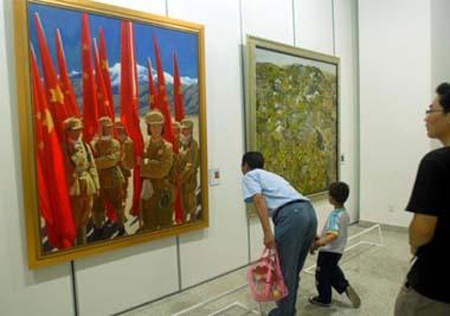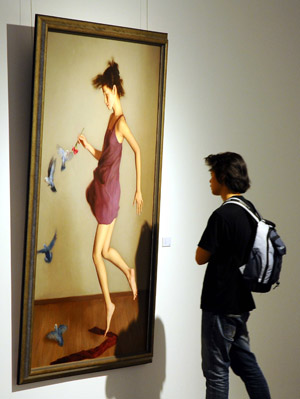
Visitors appreciate an oil painting at China's 11th National Oil
Painting Works Exhibition in Wuhan, central China's Hubei province,
Sept. 26, 2009. The exhibition which opened on Saturday opens to
the public free of charge until early November this year.(Xinhua Photo)
BEIJING, Sept.29 -- From commissioned paintings of political and historical moments to highly individualized executions of different styles and subjects. The development of Chinese art reflects the sweeping changes in Chinese society over the past sixty years. Each turn of event has been recorded on canvas, in detail and with enthusiasm, by generations of Chinese painters. Collectively, they have painted a panorama of a fast-developing society.
A journey back into history invariably leads to this critical moment for the Chinese nation. On October 1st, 1949, Chairman Mao declared the founding of New China. Even from the canvas, the nationwide jubilation is palpable. Experiencing a baptism of war and hardships, many Chinese painters turned to historical subjects in the 1950s.

A visitor views the painting exhibition "prophesy-parable" at 798 Art Zone in Beijing, capital of China, Sept. 19, 2009. The 37-day-long Beijing 798 Art Festival kicked off here on Saturday. A variety of art activities, such as Sino-German international party and sculpture art show, will be presented to art lovers.(Xinhua/Fan Jiashan)
Their choice of subjects echoed what Chairman Mao proposed. In 1956, during a meeting in Beijing, the late leader said that art should serve the people and socialism. Different views were encouraged under the slogan: "Let a hundred flowers blossom and a hundred schools of thought contend." Mao's speech sent a spasm of change through fine arts.
It all started with an article on the revival of traditional Chinese painting.
Pan Gongkai, president of central academy of fine arts, said, "The reform was to take two forms. One was to adopt western perspectives and techniques to render Chinese subjects. The other was to find a new way in indigenous culture itself. "
The rejuvenation of traditional Chinese painting was championed by artists Li Keran whose landscapes displayed strong vivid colors such as deep reds and turquoise together with western concepts of perspectives and a strong sense of contrast. The new elements are also evident in the paintings of Fu Baoshi, who also celebrated the heroism of the common people or conveyed the majesty of the motherland. New Chinese painting was carried into new heights with the Chang'an School of Painting and its forerunner Shi Lu.

Visitors view the painting exhibition "prophesy-parable" at 798 Art Zone in Beijing, capital of China, Sept. 19, 2009.(Xinhua/Fan Jiashan)
On the other side are the guardians of traditional Chinese painting, Pan Tianshou, Qi Baishi and Huang Binhong, who focused on experimenting with traditional techniques using ink, including shading and layering. They were widely praised for their freshness and spontaneity.
Using a different genre, Chinese oil painters were heading overseas. Renowned painter Jin Shangyi was one of them. Though his early interest focused mainly on revolutionary and historical subjects, Jin is best remembered for his neoclassical style with the portrait "Tajike Bride". A ray of light shines in, leaving half of the bride's facial features in shadow. The elegant tonal quality is what Jin learned in the 50s to 70s from European painters. His colleague Zhan Jianjun is another who benefited from western experiences.
Shao Dazhen, art critic, said, "The development of Chinese realism gained considerable headway in the period from l949 to l966 (after the liberation to the Cultural Revolution). The influence came from Soviet Union fine arts and Western countries. "

Visitors appreciate an oil painting at China's 11th National Oil
Painting Works Exhibition in Wuhan, central China's Hubei province,
Sept. 26, 2009. The exhibition which opened on Saturday opens to
the public free of charge until early November this year.(Xinhua Photo)
The year 1978 marked a turning point in history when the Reform and Opening Up policy was initiated. In the fine arts circle, the impact was tremendous.
Divorced from the fetters of politics, Chinese artists began to explore a new form of beauty. They combined exotic techniques and innovation to carry out rich and diverse Chinese art practices.
In 1980, at the Second National Youth Arts Exhibition, a portrait of a weather-beaten peasant caused a sensation among viewers. "Father" depicted a wrinkled old man, whose face and hands had been marred by years of labor. The painter Luo Zhongli applied natural color and photo-realism to depict an ordinary, sad old man in rural China, and in doing so, overturned the dictums of the "Cultural Revolution," which emphasized magnificence, happiness and positive themes. "Father" won first prize from visitors' votes. The image became a symbolic figure for the vast number of hoe-wielding Chinese peasants, the FATHER of a whole generation.
The rejection of artificial Cultural Revolutionary art and a turn towards earthly reality is all too familiar for Luo Zhongli and his generation of painters.
Then came Chen Danqing with his Tibetan Group Oil Paintings. The humanist emotions found in Chen's paintings show his deep understanding, compassion and respect for people at the bottom of society. The sentiments are given glorious and noble significance.
Fan Di'an, director of China National Art Museum, said, "Sixty years of change in society has offered artists common themes. In the fifties, both Chinese paintings and oils dwelt on subjects like history and socialist construction. In the eighties, after the reform and opening-up policy, their choice of subjects is much more diverse, covering all aspects of social life. Despite the variety of the subject matter, the artists have shared a common enthusiasm for their respective genre. Despite their own idiosyncrasies, the paintings collectively project the wholesome, innocent, sincere, and active stance of generations of Chinese artists."
In the 21st century, modern art has expanded rapidly, as shown in the prosperous auctions of contemporary Chinese art works. The "Big Family" series from Zhang Xiaogang has for example, won both kudos from critics and made big bucks internationally.
Chinese artists are increasingly seeking the humanism which was once lost, and nurturing an artistic spirit that fights for independence when globalization, marketization and institutionalization dominate the world. In more ways than ever, they are taking Chinese art to a new and sophisticated level.